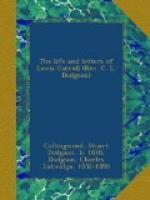[Illustration: Prof. Faraday. From a photograph by Lewis Carroll.]
His study was characteristic of the man; oil paintings by A. Hughes, Mrs. Anderson, and Heaphy proclaimed his artistic tastes; nests of pigeon-holes, each neatly labelled, showed his love of order; shelves, filled with the best books on every subject that interested him, were evidence of his wide reading. His library has now been broken up and, except for a few books retained by his nearest relatives, scattered to the winds; such dispersions are inevitable, but they are none the less regrettable. It always seems to me that one of the saddest things about the death of a literary man is the fact that the breaking-up of his collection of books almost invariably follows; the building up of a good library, the work of a lifetime, has been so much labour lost, so far as future generations are concerned. Talent, yes, and genius too, are displayed not only in writing books but also in buying them, and it is a pity that the ruthless hammer of the auctioneer should render so much energy and skill fruitless.
[Illustration: Lewis Carroll’s Study at Christ Church, Oxford.]
Lewis Carroll’s dining-room has been the scene of many a pleasant little party, for he was very fond of entertaining. In his Diary, each of the dinners and luncheons that he gave is recorded by a small diagram, which shows who his guests were, and their several positions at the table. He kept a menu book as well, that the same people might not have the same dishes too frequently. He sometimes gave large parties, but his favourite form of social relaxation was a diner a deux.
At the beginning of 1869 his “Phantasmagoria,” a collection of poems grave and gay, was published by Macmillan. Upon the whole he was more successful in humorous poetry, but there is an undeniable dignity and pathos in his more serious verses. He gave a copy to Mr. Justice Denman, with whom he afterwards came to be very well acquainted, and who appreciated the gift highly. “I did not lay down the book,” he wrote, “until I had read them [the poems] through; and enjoyed many a hearty laugh, and something like a cry or two. Moreover, I hope to read them through (as the old man said) ‘again and again.’”
[Illustration: Justice Denman. From a photograph by Lewis Carroll.]
It had been Lewis Carroll’s intention to have “Phantasmagoria” illustrated, and he had asked George du Maurier to undertake the work; but the plan fell through. In his letter to du Maurier, Mr. Dodgson had made some inquiries about Miss Florence Montgomery, the authoress of “Misunderstood.” In reply du Maurier said, “Miss Florence Montgomery is a very charming and sympathetic young lady, the daughter of the admiral of that ilk. I am, like you, a very great admirer of “Misunderstood,” and cried pints over it. When I was doing the last picture I had to put a long white pipe in the little boy’s mouth until it was finished, so as to get rid of the horrible pathos of the situation while I was executing the work. In reading the book a second time (knowing the sad end of the dear little boy), the funny parts made me cry almost as much as the pathetic ones.”




